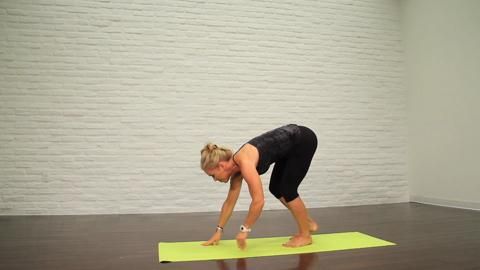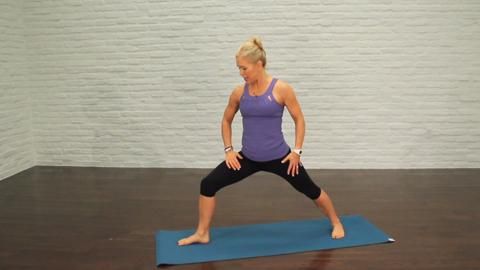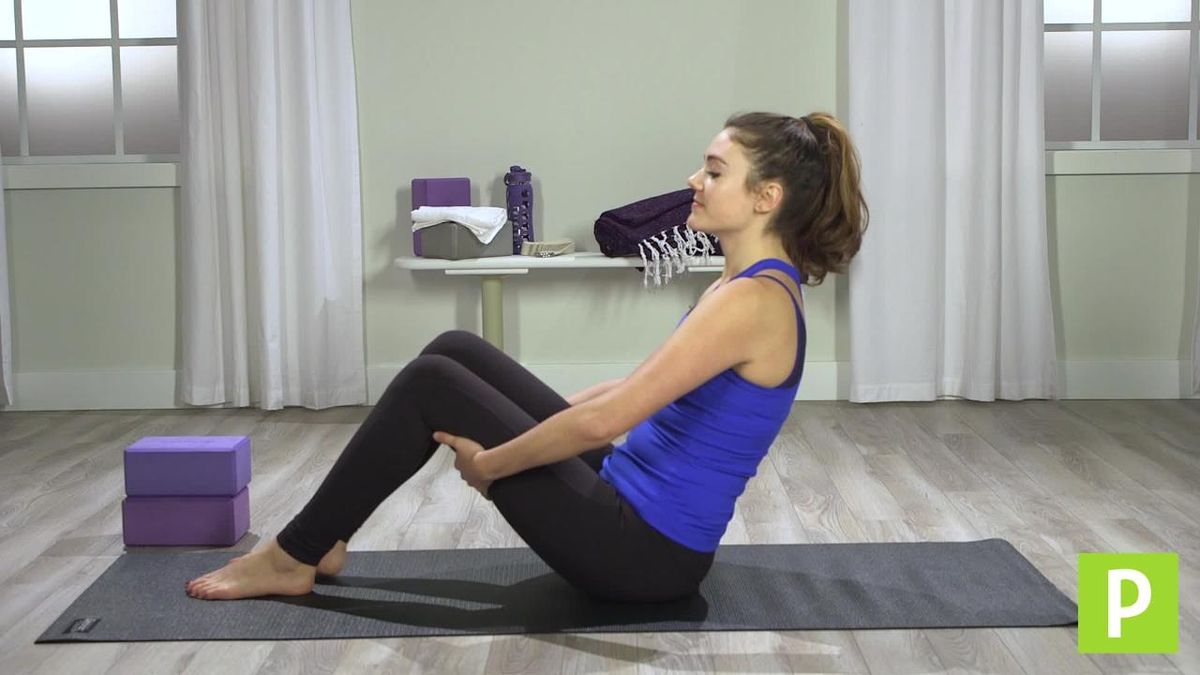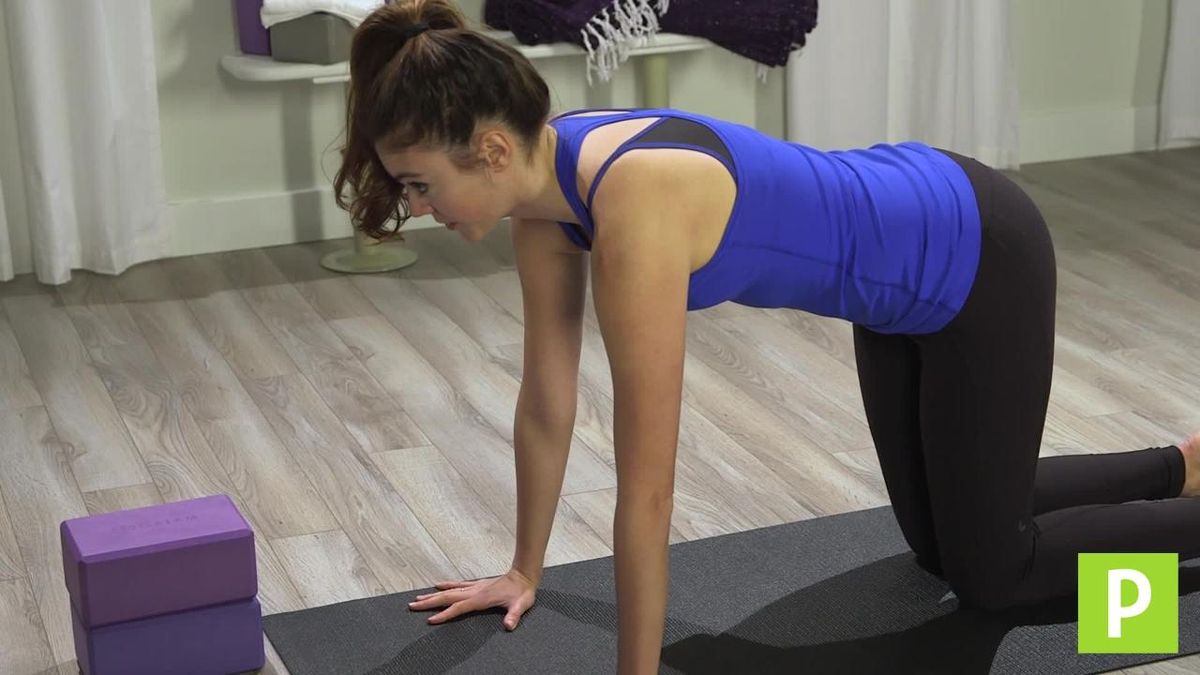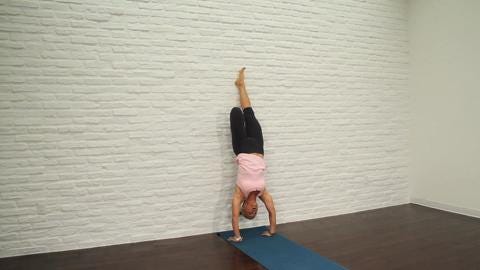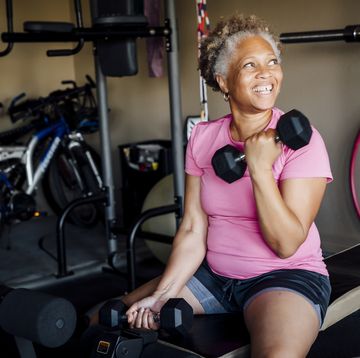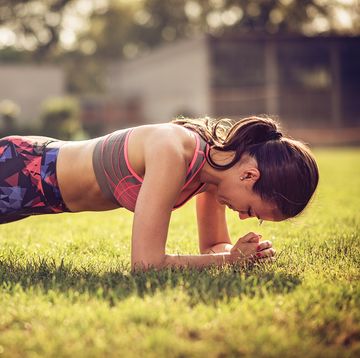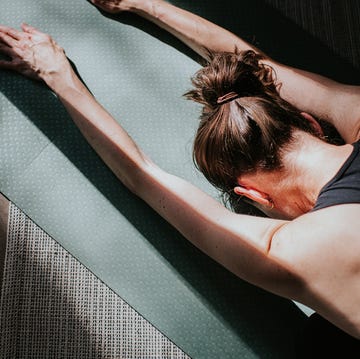We've all heard the endless benefits of yoga: stress relief, improved flexibility, lengthened muscles, enhanced balance, and greater mindfulness are just some of the perks of this spiritual and physical practice. (A recent study even found that yoga is just as effective as physical therapy for chronic low back pain.)
This is all great news for yoga lovers, but many of you probably wonder: Is it enough to do just yoga, or do you need to supplement your practice with other cardio exercise to really raise your heart rate?
This is tricky to answer because there are so many different types of yoga, but there certainly are yoga practices that qualify as effective aerobic workouts. (Hooray!) Cardiovascular, or aerobic, exercise is any movement that raises the heart rate and creates a surge in the body's use of oxygen. It's important to do this regularly because studies link regular cardio exercise to lower risk for health problems such as diabetes and heart disease—so basically, it helps you live longer. According to a 2017 study published in Complementary Therapies in Medicine, the key to turning yoga into a cardio workout is speed.
(You can also get your cardio workout in with the fat-burning walking plans in Prevention's new Walk Your Way To Better Health!)
If you want to kick off your running shoes and get your heart pumping on the mat, try this aerobic sequence below, which should take about 45 minutes total. Warm up before practicing, and take time afterward to cool down your body and slow your heart rate. This sequence is designed for intermediate to advanced students who can do these poses with proper alignment even when moving swiftly. If you're a beginner, head to a studio to nail the basics with help from an instructor—and refer to these five fixes for common poses that people often get wrong.
Sun Salutation A
- Start in Mountain Pose at the top of your mat. Inhale and sweep your arms up over your head, watching your palms meet.
- Exhale and, leading with your chest and hinging from your hips, swan dive forward over your legs. Inhale to lift up halfway, finding an elongated spine.
- Exhale, plant your hands, and find a low push-up or plank position (Chaturanga Dandasana), being sure to land with your elbows bent.
- Inhale and roll over your toes as you straighten your arms and draw your chest forward through your biceps to open your heart into Up Dog.
- Exhale, lift your hips, roll over your toes once again, to press back and up into Down Dog. Steps 3 through 5 make up one "Vinyasa" (Chaturanga, Up Dog, Down Dog).
- Inhale, look forward between your hands and, keeping your hips held high, lightly float your feet forward to the top of your mat. Exhale to forward fold over your legs.
- Inhale and, leading with your chest while maintaining an elongated spine, sweep your arms out and up over your head as you reverse your swan dive all the way up to stand. As you exhale, release your arms down by your side returning to Mountain Pose.
Repeat Sun Salutation A five times in succession, moving with speed and maintaining a steady beat with your breath. Them immediately move on to Sun Salutation B below.
PREVENTION PREMIUM: 6 Best Yoga Poses To Soothe Menopause Symptoms
Sun Salutation B
- Begin in Mountain Pose with your big toes touching and your heels slightly apart. Inhale, bend deeply into your knees and sink your hips low toward the ground as you sweep your arms up over your head, lowering into Chair Pose. Maintain your knees aligned over your ankles so that you can see all 10 toes when you look to the floor.
- Exhale and swan dive forward over your legs. Inhale and lift up halfway, finding an elongated spine.
- Exhale, float back to a low push-up position and flow through a Vinyasa, ending in Down Dog.
- Now inhale, step your right foot forward between your hands and release your left heel to the floor, angling it out about 45 degrees. Align your front heel with your back heel. Bend your front knee deeply (keeping it stacked directly over your right ankle) and square your hips forward toward the top of your mat. Sweep your arms out and up over your head as you lift your torso toward the sky. Lengthen your whole spine, finding Warrior I.
- Exhale, release your hands to frame out your front foot and step back to a plank position (Here's how to troubleshoot your plank form.) Shift your weight forward in space, until your shoulders move past the crease of your wrists, and this time, bend your elbows straight back behind you to lower yourself into Chaturanga Dandasana. Do not allow your shoulders to dip below your elbows—stop at the point just above 90 degrees in your arms.
- Flow through the rest of a Vinyasa.
- Repeat all the same steps, this time starting by bringing your left foot forward between your hands. Then, inhale, look forward between your hands and, keeping your hips held high, lightly float your feet forward to the top of your mat.
- Exhale to forward fold, then inhale (making sure your feet are touching) and bend deeply into Chair Pose as you sweep your arms up overhead.
- Exhale, straighten your legs, and release your arms as you return to Mountain Pose.
Repeat Sun Salutation B five times, moving with speed and maintaining a steady beat with your breath. Then immediately move on to Dancing Warrior Flow below.
MORE: 9 Ways Yoga Keeps You Healthy And Young
Dancing Warrior Flow
- Sweep your arms up overhead in Mountain Pose, then swan dive forward over your legs. Inhale, lift up halfway, finding an elongated spine.
- Exhale, float back to a low push-up position (Chaturanga Dandasana), and flow through a Vinyasa.
- From Down Dog, inhale and sweep your right leg toward the sky, then exhale and draw your right knee toward your nose as you round your back body and shift your weight forward into Plank, aligning your shoulders over your wrists. Inhale, reach your right leg back and up into Three-Legged Down Dog. Repeat this process two more times, shifting your weight forward into plank on your last repetition.
- Inhale to look forward, and then exhale and step your right foot forward between your hands. Ground your left heel to the floor and angle your foot out about 90 degrees so that your toes point to the left side of your mat. Create a straight line between your front heel and the arch of your back foot. Open your hips toward the left side of your mat, bend your front knee deeply, and cartwheel your arms open into Warrior II.
- Inhale, turn your right palm to face the sky. Exhale, hinging from your hips, lean the weight of your torso toward the back of your mat and rest your left hand wherever it reaches on your back leg. Extend your right arm to reach toward the back of your mat, finding Reverse Warrior. Spiral your chest open toward the sky.
- Inhale, recruit your core to draw yourself back up into Warrior II, and lean the weight of your torso forward in space to release your right forearm onto your right thigh. Sweep your left arm overhead, with your fingertips reaching toward the top of your mat and rotate your ribs toward the sky, finding Extended Side Angle Pose.
- Exhale and release your hands to frame out your feet. Step back to plank and flow through a Vinyasa.
- Repeat all the same steps, this time starting by sweeping your left leg to the sky. Then, inhale, look forward between your hands and, float your feet forward to the top of your mat. Exhale, forward fold over your legs.
- Inhale and reverse your swan dive all the way up to stand. Exhale to release your arms down by your side in Mountain Pose.
Repeat Dancing Warrior Flow five times, moving with speed and maintaining a steady beat with your breath. Then move on to the Arm Balancing/Core Strengthening Flow below.
MORE: 30-Minute Walking Workouts That Burn More Calories Than A Yoga Class
Arm Balancing/Core Strengthening Flow
- Inhale in Mountain Pose, bend deeply into your knees and sink your hips low into Chair Pose with arms overhead.
- Exhale as you sink your hips a bit lower toward the ground, then inhale to lengthen your spine up away from the ground without moving your hips. Repeat this process, sitting deeper and deeper into your seat for a few more breath cycles until you can release your seat to the floor with your knees bent and your feet flat against the ground in front of you.
- Inhale, take hold behind your knees and press your sit-bones into the mat to lengthen your spine up away from it. Exhale, squeeze your legs into the midline, expand your chest toward your thighs, and draw your bellybutton toward your spine.
- Now inhale as you lift both feet up off the floor and draw your shins parallel to your mat, finding Boat Pose. As you exhale, elongate your spine (particularly your lower back).
- Inhale, stretch your legs forward in front of you and lower your torso and your legs to hover just above the floor, finding Half Boat Pose.
- Exhale and, recruiting your core, press into your sit-bones, squeeze your legs together, and lengthen your spine to draw back up into full Boat Pose. Repeat this lift and lower five times.
- Release your feet to the floor and cross your right ankle over your left. Hug your knees in tightly toward your chest and release your palms beside your hips with your fingers spread wide. Inhale, press down firmly into your hands, lifting your legs and seat up off the floor, drawing your legs in tightly toward your body to in a compact ball. Exhale to release down to the floor.
- Repeat Boat Pose and Half Boat Pose five times. Then repeat the tuck and arm balance lift with your left ankle crossed over your right.
Immediately after finishing Arm Balancing/Core Strengthening Flow, cross your ankles and roll forward over your knees, and step into Plank Pose to do Plank Flow below.
MORE: I Did Yoga Every Morning For 2 Weeks. Here's What I Learned.
Plank Flow
- From Plank Pose, lengthen the crown of your head and your tailbone in opposite directions to create space throughout your whole spine. Then inhale and lift your right foot off the floor and reach it toward the back of your mat. Exhale, release it back down to the floor.
- Inhale, lift your right hand off the floor and draw it toward your left shoulder. Exhale, release it back down to the floor.
- Inhale, draw your bellybutton toward your spine. Exhale, release your right forearm to the floor followed by your left, finding yourself in Forearm Plank.
- Inhale, press into your right hand and straighten your right arm followed by your left and draw yourself back up into High Plank.
- Repeat all the same steps, starting on the left side with each progression.
Do this whole sequence five times on each side then immediately move on to the Inversions Flow below.
MORE: 3 Ways To Tone Your Chest And Shoulders Without Doing A Single Push-Up Or Plank
Inversions Flow
*Note: You may want to use a wall behind you for this flow.
- From Plank Pose, lift your hips up and back into Down Dog.
- Inhale, look forward between your hands, place a very slight bend into your knees, and lift your hips up high. Then as you exhale, spring off of both your feet and draw them in toward your seat as you float your hips over your shoulders, lifting to Tuck Handstand. (Can't do one? This move is way easier and offers the same health benefits.)
- Inhale, gently release your feet back to the floor, engaging your core and bending your knees as you land.
- Float up and down 10 times, practicing these "donkey kicks" and maybe even finding some "hang time" in the air in Handstand.
Release down into Child's Pose and stay for a few long, deep breaths before moving into your cooldown. (Try unwinding with these six restorative yoga poses.)

